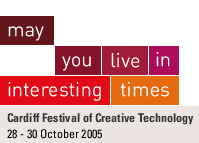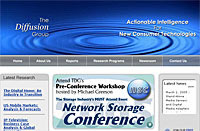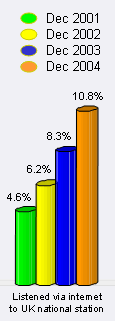 Xbox 360, Microsoft’s successor to their popular Xbox gaming console, will be “unleashed” tonight at a celebrity-packed launch broadcast on MTV, which shows at 8pm in the UK. It was launched on US MTV last night.
Xbox 360, Microsoft’s successor to their popular Xbox gaming console, will be “unleashed” tonight at a celebrity-packed launch broadcast on MTV, which shows at 8pm in the UK. It was launched on US MTV last night.
With a press release positively hyperventilating with hyperbole, Microsoft breathlessly extols the virtues of their new games machine, dramatically waffling on about “a dawn of a new era in entertainment.”
Unlike the manly, chunky lines of the first-generation Xbox, the 360 has been given the ladyboy treatment, with smooth, concave lines covering the rippling muscle lurking below.
And there certainly is a beast in the box, with the unit powered by a custom-made IBM PowerPC-based three-core chip running at 3.2GHz, supported by 512MB of GDDR3 RAM – enough beefy brawn to keep up with even the nippiest modern PCs.
Graphics performance should be speedier than a rocket-assisted rabbit too, with an ATI GPU running at 500MHz, backed up by 10MB of embedded DRAM.
 The Xbox will ship with a 12X dual-layer DVD-ROM drive – supporting progressive-scan DVD movies and a host of DVD and CD formats – three USB 2.0 ports, two memory unit slots and support for four wireless game controllers.
The Xbox will ship with a 12X dual-layer DVD-ROM drive – supporting progressive-scan DVD movies and a host of DVD and CD formats – three USB 2.0 ports, two memory unit slots and support for four wireless game controllers.
Users will also be able to stream media from portable devices or Windows XP PCs, as well as rip music to the Xbox’s detachable (and upgradeable) 20GB hard drive.
Networking needs are catered for with a built-in Ethernet port and support for 802.11a, b, and g Wi-Fi protocols.
“With the first generation of Xbox, our ambition was to change the way people think about video games,” said Robbie Bach, chief Xbox officer at Microsoft. “Starting today with Xbox 360, our ambition is to transform the way people play games and have fun.”
Microsoft – never one to understate their case – are claiming that they will “unleash the greatest game lineup in the history of video games” when the Xbox launches in North America, Europe and Japan over Christmas.
They’ve certainly persuaded a gaggle of major league gaming companies to come onboard, with initial releases including NBA 2K6, Call of Duty 2, QUAKE 4, Madden NFL 06, Need for Speed Most Wanted and Tiger Woods PGA TOUR 06.
 “Xbox 360 marks the beginning of a renaissance in video games,” whooped Don Mattrick, president of Worldwide Studios for Electronic Arts. “The unbelievable Xbox 360 games in development at Electronic Arts will accelerate the industry’s mission to make video games the pre-eminent form of all entertainment.”
“Xbox 360 marks the beginning of a renaissance in video games,” whooped Don Mattrick, president of Worldwide Studios for Electronic Arts. “The unbelievable Xbox 360 games in development at Electronic Arts will accelerate the industry’s mission to make video games the pre-eminent form of all entertainment.”
All the games are designed for high-definition, wide-screen televisions, although they’ll work on regular TVs.
Players will be able to access Microsoft’s free Xbox Live online service, which allows them to connect with friends through Xbox Live voice chat, send and receive text and voice messages and stuff their detachable Xbox 360 hard drive full of downloadable demos, trailers, new game levels, maps, weapons, vehicles, skins and community-created content
Gamers who shell out for the premium service, Xbox Live Gold, can join multiplayer online games and enjoy enhanced options for online game matchmaking and a greater ability to provide feedback on opponents.
 Naturally, gamers love to customise their experience, so there’s a camera option to let vain players add their mugshots into games or even see their friends onscreen as they frag them to an inch of their worthless lives.
Naturally, gamers love to customise their experience, so there’s a camera option to let vain players add their mugshots into games or even see their friends onscreen as they frag them to an inch of their worthless lives.
As is the current vogue, the appearance of the actual Xbox can be customised too, with a range of interchangeable Xbox Faces on offer.
Although the system is aimed at mad-for-it gamers, the Xbox is also a full entertainment system offering DVD movie, CD music and photo playback support.
So long as they’re equipped with a USB 2.0 port, MP3 players, digital cameras and Windows XP-based PC port can all plug into an Xbox 360 system to stream music and photos.
 Xbox 360 players can also access recorded TV and digital movies, music, video and photos stored on Windows XP Media Center Edition 2005-based PCs through any Xbox 360 system in the house.
Xbox 360 players can also access recorded TV and digital movies, music, video and photos stored on Windows XP Media Center Edition 2005-based PCs through any Xbox 360 system in the house.
We’ve yet to get our greasy paws on a machine, but Microsoft have certainly raised the stakes with their new Xbox, although arch rivals Sony have yet to, err, unleash their PlayStation 3, a potentially more powerful box offering support for new high-capacity Blu-ray discs.
With both units enjoying enthusiastic support from game makers and gamers, some of the real bloody battles could soon be taking place off-screen.
Promo video for Xbox 360 (Windows Media)
If you thought Xbox 360 was just about gaming, skip to 3 minutes into the video to see how they’re transforming it into a media centre.
XBox
 Browsing Gmail, Google’s email service, wasn’t particularly great when you did it from a mobile … until now. With the new release of gmail mobile that was launched today.
Browsing Gmail, Google’s email service, wasn’t particularly great when you did it from a mobile … until now. With the new release of gmail mobile that was launched today. The festival has been developed by Bloc (Creative Technology Wales) and Chapter Arts Centre, Cardiff. They have managed to accommodate a large number of complex yet accessible projects. This collaboration is all the more impressive in its scale when you realise that both organisations have their own projects running concurrently (Bloc are developing Northern and Southern pilot projects in Wales with accompanying seminars; Chapter are hosting the first UK showing o the artists Olaf Breuning).
The festival has been developed by Bloc (Creative Technology Wales) and Chapter Arts Centre, Cardiff. They have managed to accommodate a large number of complex yet accessible projects. This collaboration is all the more impressive in its scale when you realise that both organisations have their own projects running concurrently (Bloc are developing Northern and Southern pilot projects in Wales with accompanying seminars; Chapter are hosting the first UK showing o the artists Olaf Breuning). To join in you can access a number of computer terminals at the National Museum and Gallery or at one of the festival hubs at Chapter or g39 (cor). If you are unable to visit you can play from your own
To join in you can access a number of computer terminals at the National Museum and Gallery or at one of the festival hubs at Chapter or g39 (cor). If you are unable to visit you can play from your own  The artist group Second Site will be displaying new video works in the windows of a empty bank on Bute Street, while Chris Evans will project his interactive game onto St John’s Church in the centre of Cardiff.
The artist group Second Site will be displaying new video works in the windows of a empty bank on Bute Street, while Chris Evans will project his interactive game onto St John’s Church in the centre of Cardiff. It’s a fact of life – almost everywhere we turn we are surrounded by technology. From mobile phones and digital cameras to TVs and video games. But as well as making our lives easier and providing us with entertainment, more and more artists are now turning to everyday technologies when they create their work.
It’s a fact of life – almost everywhere we turn we are surrounded by technology. From mobile phones and digital cameras to TVs and video games. But as well as making our lives easier and providing us with entertainment, more and more artists are now turning to everyday technologies when they create their work. “The event will be held at various sites across the capital and will illuminate the city with dynamic and individual work using a range of new and existing technologies,” said festival co-director Emma Posey.
“The event will be held at various sites across the capital and will illuminate the city with dynamic and individual work using a range of new and existing technologies,” said festival co-director Emma Posey. “We want to create a vibrant creative technology sector in Wales, with the festival celebrating this every two years.”
“We want to create a vibrant creative technology sector in Wales, with the festival celebrating this every two years.” The BBC has teamed up with Hewlett-Packard Labs and Gavitec to provide a digital collaboration based around the BBC TWO series, Coast.
The BBC has teamed up with Hewlett-Packard Labs and Gavitec to provide a digital collaboration based around the BBC TWO series, Coast. For phone-allergic types, the BBC will also make MP3 audio from the project available as a free download from bbc.co.uk.
For phone-allergic types, the BBC will also make MP3 audio from the project available as a free download from bbc.co.uk. Xbox 360, Microsoft’s successor to their popular Xbox gaming console, will be “unleashed” tonight at a celebrity-packed launch broadcast on MTV, which shows at 8pm in the UK. It was launched on US MTV last night.
Xbox 360, Microsoft’s successor to their popular Xbox gaming console, will be “unleashed” tonight at a celebrity-packed launch broadcast on MTV, which shows at 8pm in the UK. It was launched on US MTV last night. The Xbox will ship with a 12X dual-layer DVD-ROM drive – supporting progressive-scan DVD movies and a host of DVD and CD formats – three USB 2.0 ports, two memory unit slots and support for four wireless game controllers.
The Xbox will ship with a 12X dual-layer DVD-ROM drive – supporting progressive-scan DVD movies and a host of DVD and CD formats – three USB 2.0 ports, two memory unit slots and support for four wireless game controllers. “Xbox 360 marks the beginning of a renaissance in video games,” whooped Don Mattrick, president of Worldwide Studios for Electronic Arts. “The unbelievable Xbox 360 games in development at Electronic Arts will accelerate the industry’s mission to make video games the pre-eminent form of all entertainment.”
“Xbox 360 marks the beginning of a renaissance in video games,” whooped Don Mattrick, president of Worldwide Studios for Electronic Arts. “The unbelievable Xbox 360 games in development at Electronic Arts will accelerate the industry’s mission to make video games the pre-eminent form of all entertainment.” Naturally, gamers love to customise their experience, so there’s a camera option to let vain players add their mugshots into games or even see their friends onscreen as they frag them to an inch of their worthless lives.
Naturally, gamers love to customise their experience, so there’s a camera option to let vain players add their mugshots into games or even see their friends onscreen as they frag them to an inch of their worthless lives. Xbox 360 players can also access recorded TV and digital movies, music, video and photos stored on Windows XP Media Center Edition 2005-based PCs through any Xbox 360 system in the house.
Xbox 360 players can also access recorded TV and digital movies, music, video and photos stored on Windows XP Media Center Edition 2005-based PCs through any Xbox 360 system in the house. If you’ve ever accessed the Web through a mobile phone or PDA, you may be familiar with the annoyance of finding some sites inaccessible, hard to read or just a right royal pain in the Bluetooth.
If you’ve ever accessed the Web through a mobile phone or PDA, you may be familiar with the annoyance of finding some sites inaccessible, hard to read or just a right royal pain in the Bluetooth. “Web access today is so fundamental, that it shouldn’t be hampered by wires,” table-thumped Philipp Hoschka, W3C’s deputy director for Europe.
“Web access today is so fundamental, that it shouldn’t be hampered by wires,” table-thumped Philipp Hoschka, W3C’s deputy director for Europe. See our interview with co-founder of OurMedia,
See our interview with co-founder of OurMedia,  Evidence is beginning to amass that two of the most hyped products in the early digital home market will be lucky if they manage to reach niche market status in the next few years.
Evidence is beginning to amass that two of the most hyped products in the early digital home market will be lucky if they manage to reach niche market status in the next few years. The European Parliament has voted in favour of a new programme to promote the European digital content market, setting it a budget of €149m (~$194m, ~£103m) for the next three years.
The European Parliament has voted in favour of a new programme to promote the European digital content market, setting it a budget of €149m (~$194m, ~£103m) for the next three years. It’s worth clarifying that the Internet figures include any listening of the radio on a computer, whether live streaming, using services like the BBC’s RadioPlayer/Listen Again, or Podcasting (download and play).
It’s worth clarifying that the Internet figures include any listening of the radio on a computer, whether live streaming, using services like the BBC’s RadioPlayer/Listen Again, or Podcasting (download and play). The largest area of growth has been in people listening to UK National radio stations over the Internet. This has increased from 8.3% a year ago to 10.8% of the UK population, equating to just short of 4.8m people. It is thought that this is probably due to an raised awareness that the Internet can be used to listen to the radio, helped in no small part by the BBC pushing the service.
The largest area of growth has been in people listening to UK National radio stations over the Internet. This has increased from 8.3% a year ago to 10.8% of the UK population, equating to just short of 4.8m people. It is thought that this is probably due to an raised awareness that the Internet can be used to listen to the radio, helped in no small part by the BBC pushing the service.